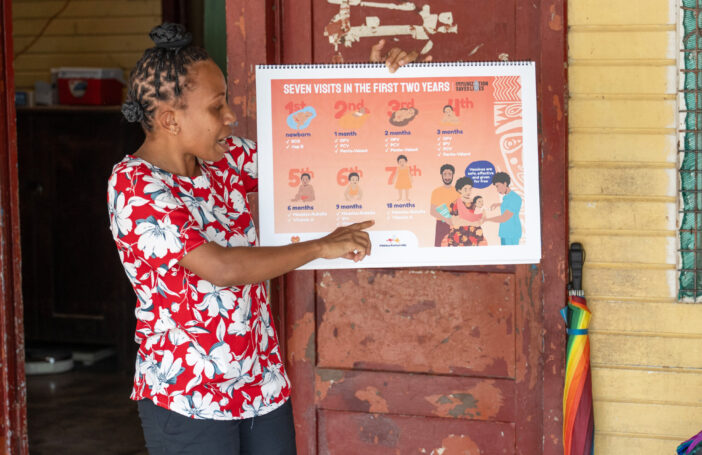Menstrual health is essential to gender equality and the well-being of women, adolescent girls and all people who menstruate. Yet the menstrual health needs of millions of girls and women continue to go unmet; and those who menstruate face restrictions on their mobility, choices, and participation in school and community life. As Menstrual Hygiene Day celebrations start to flow again this month, it is time to ask: are we making progress towards fulfilling menstrual health needs in the East Asia and Pacific region?
Menstrual health as defined by a group of experts in 2021 is “a state of complete physical, mental and social well-being and not merely the absence of disease or infirmity, in relation to the menstrual cycle”.
Achieving menstrual health requires that women, girls and all other people who experience a menstrual cycle are able to: access accurate, timely, age-appropriate information; care for their bodies during menstruation; participate in all spheres of life during all phases of the menstrual cycle without discrimination; experience a supportive social environment; and access care for menstrual cycle-related discomfort and disorders.
Figure 1: Requirements for achieving menstrual health
Source: Alexandra Head, Chelsea Huggett, Pisey Chea, Heather Suttor, Brooke Yamakoshi and Julie Hennegan (2023), ‘Menstrual health in East Asia and the Pacific: regional progress review’, United Nations Children’s Fund, Burnet Institute and WaterAid, Bangkok, p. vi
Our new regional progress review (a collaboration between UNICEF, the Burnet Institute and WaterAid) summarises progress in menstrual health-related policies, service delivery, and evidence over the past five years across 19 countries in East Asia and the Pacific. The report draws on a desk review of policy documentation and targeted stakeholder surveys and informant interviews, along with a systematic review of published and grey literature on the effectiveness of menstrual health interventions.
We found that across the East Asia and Pacific region there has been significant progress in the attention given to menstruation. Most progress has focused on providing access to information and education, and access to materials, facilities and services such as water, sanitation and hygiene. The other three requirements for menstrual health – access to care, a supportive social environment, and non-discrimination – have received significantly less attention.
Schoolgirls have received most attention, with most menstrual health programs delivered through schools. While adolescence is an important time for support, we urgently need pathways beyond schools to reach girls with disabilities, out of school children, and adult women. As one review informant from Fiji said, “no one is caring about ageing women. Who is talking to them?”.
But our review also found that increased policy attention alone has not always resulted in implementation of policies. Across East Asia and the Pacific, some progress has been made on including menstrual health in water, sanitation, hygiene, education and health policies, strategies and guidelines. However, the lack of clear roles and responsibilities among different sectors and levels of government remains the biggest bottleneck to policy intentions seeing funding and implementation.
The biggest gap of all remains the evidence base to inform practice and provide accountability. Our review of academic and grey literature found there is insufficient evidence to establish the effectiveness of any menstrual health interventions in East Asia and the Pacific.
So, what needs to happen to achieve menstrual health for all?
First, governments and development practitioners must attend to all five requirements of menstrual health. The definition of menstrual health can serve as a framework to assess progress and identify gaps.
Second, evidence is urgently needed to guide the selection of policy initiatives that work to improve menstrual health experiences and outcomes. Despite the critical importance of a strong evidence base, little funding has been directed to rigorous evaluations or trialling candidate policy and practice interventions.
Third, national policies are necessary but not sufficient to enable progress on menstrual health. Where relevant sector policies don’t yet address menstrual health, they need to be reviewed. Where policies and strategies already include menstrual health, strong institutional arrangements, costings, and budget allocations are needed.
Fourth, investment in capacity strengthening is needed for menstrual health across the health, water, sanitation and hygiene, education and other relevant sectors. Aspects of menstrual health are often secret or taboo, and support is needed to ensure that scientifically accurate and age-appropriate support reaches girls and women.
Fifth, improved monitoring of menstrual health at multiple levels, including national monitoring and integration into the monitoring and evaluation of individual programs, is essential for accountability, to track progress and to inform better practice. Governments can use new developments such as the 2022 publication of a set of priority indicators to guide national monitoring of menstrual health and to incorporate it into national education and health management information systems.
Many governments – including Australia – have been gradually increasing their attention and commitment to menstrual health in East Asia and the Pacific region. Menstrual health features in the Pacific Women Lead program as part of new areas of sexual and reproductive health and rights; and at the UN Human Rights Council 50th session (June 2022) Australia made a national statement – during the panel discussion on menstrual hygiene management, human rights and gender equality – calling for menstrual health to be addressed through climate response efforts. DFAT is supporting innovations like the Oky period tracker app in Indonesia, the Philippines and Papua New Guinea – which includes adapted formats for children with disabilities – that are providing new pathways to reach people with accurate and consistent information outside of schools.
Australia’s development agenda must continue to drive greater momentum towards menstrual health to achieve broader goals on gender equality. Quality investment is urgently needed for rigorous evidence, strengthened policies and service delivery, and secure and sustained funding for scaling up holistic solutions for this bloody essential part of life.





